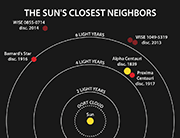E-Archive
Off the Beaten Track
in Vol. 16 - September Issue - Year 2015
Where No Man Has Gone Before

Image of Pluto sent by New Horizons probe

The spectacular images of the planet Pluto sent back by the New Horizons space probe in July 2015 triggered renewed interest in deep space exploration.
New Horizons was launched in January 2006 and took over nine years to cover a distance of over five billion kilometers. Its initial launch speed from Earth was about 16 km/second (about 58,000 km/h), setting a record for the fastest launch speed of any man-made object from Earth. New Horizons will continue its mission on to the Kuiper Belt, at the edge of our Solar System, where the probe is expected to arrive in 2019.
At present, the farthest space probe from Earth is Voyager 1, launched in September 1977 and which reached the edge of the Solar System in December 2011. Thanks to the gravity effect when it flew past Jupiter and Saturn, Voyager 1 is currently travelling through space faster than New Horizons. Voyager 1 entered interstellar space in August 2012 and will continue to operate and send back data until about 2025, when its electric power generators are expected to stop working.
The distances travelled and the speeds achieved by New Horizons and by Voyager 1 are impressive. Other unmanned probes launched over the past few decades have contributed enormously to our understanding of the Solar System. However, if we are to make a qualitative leap in our knowledge of the universe, it's necessary to plan and create more sophisticated and advanced forms of space exploration.
Manned and unmanned interplanetary and interstellar space travel would require spacecraft with performance levels that are currently unachievable. These missions would also pose a series of daunting technological and economic challenges.
First of all, consider the distances involved. Distances between planets and the Sun in our Solar System are usually expressed in Astronomical Units (AU), being the average distance between the Sun and the Earth (about 150 million kilometers). On the other hand, distances between stars, being much greater, are normally expressed in light years, defined as the distance travelled by a beam of light in a vacuum in one year (almost ten trillion kilometers, or over 63,000 AU). Well, the nearest known star outside of our Solar System, Proxima Centauri, is slightly over four light years away, equivalent to over 268,000 AU. By comparison, Pluto orbits the Sun at an average distance of about 40 AU. If Voyager 1 were travelling towards Proxima Centauri, it would take almost 74,000 years to reach its destination! In order to reach other stars within the lifespan of an average human being, manned spacecraft would have to achieve speeds which current technology cannot provide. In addition, the energy required to propel such vehicles would be enormous by today's standards of energy production. Various solutions, ranging from nuclear fission, nuclear fusion, antimatter and ion rockets to speculative methods (quark matter, Hawking radiation, magnetic monopole rockets) are being studied. Research is also being done on faster-than-light propulsion (Alcubierre drive, artificial gravity control, wormholes, etc.).
Even if an adequate means of propelling the spacecraft at the extremely high speeds needed for interstellar travel were found, collisions between the spacecraft and cosmic dust and gas would cause devastating damage to the vehicle. This means that new and extremely resistant material would have to be invented.
Communications over extremely long distances are difficult, if not impossible. Since information cannot travel faster than the speed of light, communications between the Earth and, say, the nearest star Proxima Centauri would take no less than eight years to travel one way and an additional eight years to return.
Last but not least, in the case of manned spacecraft, scientists are studying the effects that interstellar travel would have on astronauts. Food and water supplies must be kept at adequate levels and this would require the production of these staples on board the spaceship. Prolonged weightlessness causes muscles to atrophy and also leads to bone deterioration: various methods of creating artificial gravity are being pondered. Dangerous radiation in space comes from high speed electrons and protons generated by the Sun and from positively charged atomic nuclei coming from supernovas. Living in a cramped and enclosed environment for months or years would have a tremendous negative impact on the psychological condition of space travellers.
Even though the obstacles seem overwhelming, scientists around the world are quietly working on possible solutions, for they know that it is our destiny to seek our future among the stars.
By Giovanni Gregorat, Contributing Editor MFN
Author: Giovanni Gregorat



























